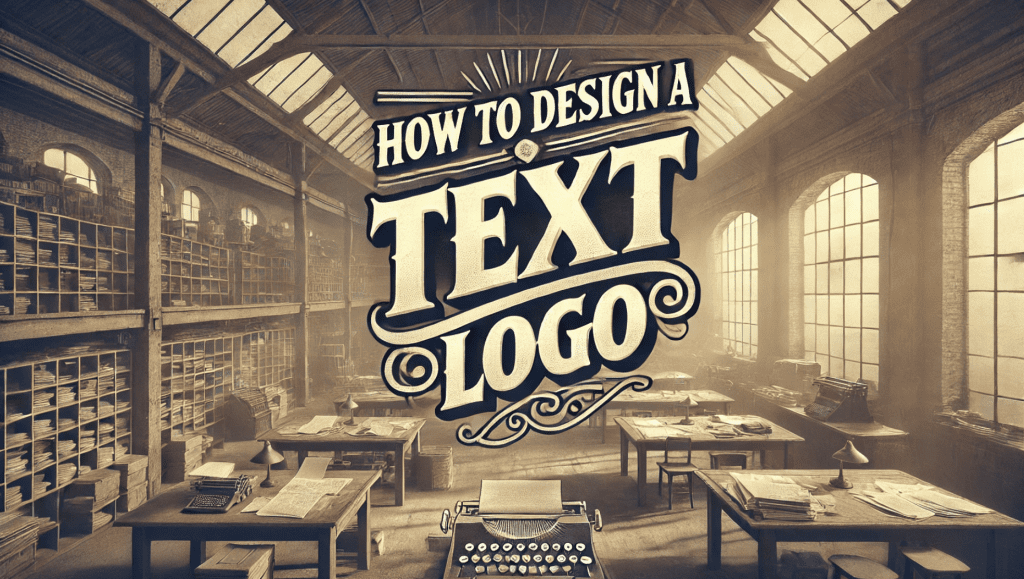Creating an impactful, memorable logo is a foundational step for establishing a strong brand identity. Text-based logos—or wordmarks—use only typography, color, and layout to convey a brand’s personality and values. Without relying on icons or graphics, text-based logos require careful attention to design elements, where even small decisions around font, color, and spacing can have a significant impact. This guide provides a comprehensive, step-by-step approach to crafting a text-based logo mark that incorporates unique typography to enhance brand recognition and clarity.
Understanding the Purpose of a Text Logo
Text-based logos focus solely on the brand name itself, removing other imagery and using typography as the primary design element. Household brands like Google, Calvin Klein, and FedEx exemplify the power of wordmarks to build recognition. This approach is especially effective for brands looking to:
- Maximize Brand Recognition: By spotlighting the name alone, a text-based logo makes it easier for audiences to remember the brand.
- Convey Brand Character Through Typography: Typography allows a logo to reflect brand personality, whether sophisticated, casual, or edgy.
- Achieve Timelessness and Versatility: A text-based logo can adapt more easily over time, especially since it avoids trend-based graphics that can quickly become dated.
A text-based logo also ensures high adaptability across media, making it particularly effective for brands wanting a versatile, long-lasting identity.
Conducting Market Research
Market research provides insight into how competitors approach text-based logos, which helps you make informed design decisions and uncover opportunities to stand out. Here’s how to structure this research:
- Analyze Competitors: Examine typography, color schemes, and layouts in logos of similar brands. This will help you identify effective design trends and avoid common themes that may be overused.
- Identify Industry Style Norms: Many industries have specific typography preferences (e.g., modern sans-serifs in tech or bold serifs in finance). Understanding these conventions can guide you toward alignment with or deviation from them, depending on your brand’s goals.
- Gather Broader Inspiration: Look at logos across various industries for inspiration on how different brands creatively use typography and layout.
Effective market research helps clarify your design direction and highlights ways to distinguish your brand from competitors in a crowded landscape.
Defining Brand Identity and Personality
Defining your brand’s identity is a crucial step in guiding your design decisions and ensuring that each element of the logo supports your overall brand message. Reflect on the following aspects to shape your logo’s character:
- What Are Your Brand’s Core Values? List attributes that define your brand, such as “reliable,” “sustainable,” “innovative,” or “friendly.” These attributes will help steer the logo’s tone and style.
- Who Is Your Target Audience? Consider the preferences and values of your target demographic. If your audience values tradition and prestige, a serif font may be appropriate; if they prioritize modernity and simplicity, a clean sans-serif might be a better choice.
- What Message Should the Logo Convey? Decide on the tone you want your logo to set—professional, approachable, luxurious, or casual. This will directly influence typography and color decisions.
A strong brand identity serves as a foundation, ensuring that each design choice, from font selection to layout, reinforces the brand’s core message and purpose.
Selecting the Right Font: Types, Weights, and Resources
Typography is the backbone of any text-based logo, and selecting the right font is essential to conveying your brand’s essence. Here’s an overview of the main categories:
- Serif Fonts: With their small decorative “feet,” serif fonts (e.g., Times New Roman, Garamond) convey tradition, professionalism, and reliability. They are ideal for brands that emphasize heritage, sophistication, or elegance, like Tiffany & Co. or Gucci.
- Sans-Serif Fonts: Clean and versatile, sans-serif fonts (e.g., Helvetica, Arial) offer a modern, minimalist look. Known for their readability on screens, sans-serif fonts are popular among tech and media brands that prioritize simplicity and adaptability. Examples include Google, Facebook, and Netflix.
- Script Fonts: Script fonts mimic handwriting, offering a sense of elegance, warmth, and creativity. These fonts work well for lifestyle, personal, or artisanal brands, providing a personal touch. Companies like Cadbury and Coca-Cola effectively use script to convey friendliness and charm.
- Display Fonts: Bold and highly stylized, display fonts are best for brands aiming to stand out with unique visual appeal. Disney, for instance, uses a distinctive display font to capture its imaginative spirit, but readability should be a priority to ensure the name remains clear.
Suggested Font Resources:
- Adobe Fonts: Adobe offers a large, professional-grade font library with both classic and unique options, accessible directly within Adobe software like Illustrator.
- Google Fonts: A free, open-source font library with extensive typefaces and detailed descriptions of each font’s background.
- DaFont: Known for its wide variety of decorative and unconventional fonts, DaFont is a useful resource for exploring unique options, especially for more stylized logos.
- Typotheque and MyFonts.com: Both provide high-quality, unique fonts, catering to specific design needs and offering professional licensing options.
Font selection is critical to establishing the look and feel of a text-based logo, so take time to experiment and compare options until you find a style that perfectly represents your brand.
Curating a Cohesive Color Palette
Color is a powerful design element that significantly influences a logo’s emotional impact and helps shape how the brand is perceived. Here’s how to make thoughtful color choices for your logo:
- Align with Brand Colors: Choose colors that match or complement your brand’s established color scheme, reinforcing visual consistency across branding.
- Consider Color Psychology:
- Red: Symbolizes passion, energy, and urgency, making it ideal for brands that want to communicate excitement and strength (e.g., Coca-Cola, Red Bull).
- Blue: Conveys calm, professionalism, and trustworthiness. Blue is commonly used in tech and finance sectors due to its association with stability and dependability (e.g., IBM, Facebook).
- Green: Often linked to nature, health, and sustainability, green is popular among brands with environmental or wellness focuses (e.g., Whole Foods, Spotify).
- Black and White: Communicate sophistication, luxury, and simplicity. Monochromatic logos like Chanel or Apple use black-and-white to convey elegance and timelessness.
- Yellow: Represents optimism, warmth, and positivity. Yellow can create a sense of energy and friendliness, appealing to audiences looking for a welcoming brand (e.g., McDonald’s, Snapchat).
Limit your color palette to two or three shades for simplicity, balance, and cohesion. Experiment with color pairings and consider using gradients or shading to add subtle depth. Brands like Google, with its multi-colored wordmark, convey creativity and inclusivity, while monochromatic logos like Nike’s emphasize sleekness and sophistication.
Considering a Website URL as Your Text Logo
Using a website URL as a text-based logo can be a strategic choice, especially for online-first businesses or brands with unique domain names. This approach can:
- Strengthen Brand Recognition: Displaying the URL as the logo encourages audiences to remember and visit the site, integrating branding with functionality.
- Increase Direct Traffic: Having a URL in the logo makes it easy for viewers to recall and access your website, enhancing visibility and customer engagement.
- Communicate a Digital-First Identity: A URL in the logo signals that the brand operates primarily online, which can appeal to digital-savvy audiences.
Ensure that the font and layout keep the URL legible and easy to read at different sizes. Adding a website URL to the logo is particularly effective for tech startups, SaaS businesses, and other digitally native brands.
Designing for Accessibility and Low Vision
To ensure inclusivity, consider how your text-based logo will be perceived by all users, including those with low vision. Here are some best practices:
- Use High Contrast: Strong contrast between text and background improves readability, making the logo more accessible for visually impaired users. Bold, clear colors enhance visibility and readability.
- Prioritize Legible Fonts: Choose fonts with open shapes and sufficient spacing. Avoid overly stylized or condensed fonts, as these can make the logo hard to read, especially at smaller sizes.
- Optimize X-Height and Weight: Fonts with a larger x-height (the height of lowercase letters relative to uppercase letters) are generally easier to read. Additionally, using thicker font weights improves readability for people with low vision.
- Offer Multiple Versions: Create both high-contrast and standard versions of your logo to ensure visibility on different backgrounds and in various lighting conditions.
Designers like Pablo Navarlaz, who specialize in typography for low vision, underscore the importance of flexible, accessible typefaces that maintain aesthetic quality. By designing for accessibility, you make your brand more inclusive, improving readability and engagement across all audiences.
Crafting a Layout and Optimizing Spacing
A well-organized layout ensures readability and enhances visual appeal. Consider the following:
- Horizontal, Vertical, or Stacked Layouts: Experiment with different alignments to see which best represents your brand’s tone. Horizontal layouts are compact and traditional, while stacked arrangements offer a modern aesthetic.
- Kerning and Letter Spacing: Adjust the space between letters (kerning) to balance readability and style. Wider kerning creates a luxurious, airy feel, while tighter kerning conveys professionalism and conciseness.
- Line Spacing for Multi-Line Logos: For multi-line logos, tight line spacing ensures cohesion, while wider spacing creates an open, relaxed feel.
Creating a balanced layout is essential; too much space can reduce impact, while too little can hinder readability.
Adding Unique Touches
Personalize your text-based logo with subtle design elements that reinforce brand identity:
- Symbolic Letter Replacements: Replacing one letter with a symbol related to your brand can add personality. For example, Pixar’s logo uses a lamp in place of the “I,” reinforcing the brand’s identity.
- Subtle Visual Effects: Add depth with shadows, outlines, or textures, but use these effects sparingly to maintain readability. Photoshop and Illustrator offer a variety of tools for creating subtle effects that enhance visual appeal.
- Blending Techniques: Experiment with blending modes and opacity for creative variations. Keep effects minimal to ensure the logo remains clean and professional.
Small, unique touches help your logo stand out and reinforce its memorability without sacrificing readability.
Converting to Vector for Versatility
To ensure that your logo maintains quality at any size, convert it to a vector format, such as SVG or PDF. Vectors are scalable and retain clarity across applications, from digital screens to print materials. Adobe Illustrator is ideal for vectorizing logos, allowing for precise scaling and crisp visuals across all branding assets.
Testing and Iterating Across Different Mediums
Testing your logo across various mediums and contexts can reveal areas for improvement:
- Background Compatibility: Test your logo on different backgrounds, including light, dark, and colored surfaces. Adjust colors or effects as needed to ensure readability.
- Size and Legibility: Check how the logo appears at various sizes, from small icons to large signage. Ensure the logo remains readable and visually balanced.
- Cross-Platform Consistency: See how the logo looks on websites, social media, printed materials, and merchandise to verify that branding is consistent and clear.
Seek feedback from colleagues or focus groups to identify any additional refinements. Testing provides valuable insight into how well your logo performs in real-world applications.
Pro Tips for a Timeless Text-Based Logo
Creating a lasting text-based logo requires strategic simplicity, clarity, and brand alignment. Here are some final tips:
- Prioritize Minimalism: Keep the design clean and scalable, focusing on essential elements.
- Seek Objective Feedback: Gather input from colleagues, clients, or target audiences to ensure the logo resonates with your brand and audience.
- Iterate and Refine: Don’t be afraid to revisit and adjust your design until each element aligns seamlessly with your brand identity.
The Power of Text-Based Logos: Iconic Examples
Many top brands demonstrate the power of well-executed text logos:
- Google: Known for its multi-colored wordmark, Google’s logo communicates creativity, inclusivity, and approachability.
- IBM: The IBM logo’s bold, striped letters convey strength, precision, and innovation.
- FedEx: Featuring a hidden arrow within the logo, FedEx communicates speed and efficiency through a subtle design choice.
- Disney: The whimsical, stylized font of Disney’s wordmark embodies the brand’s imagination and sense of wonder.
These examples illustrate how text logos can create an enduring brand identity by conveying personality and values with minimal elements.
Closing Thoughts
Designing a text-based logo is an art that requires a thoughtful approach to typography, color, layout, and accessibility. By aligning design choices with brand identity, testing across platforms, and incorporating subtle personal touches, you can create a logo that is not only memorable and clear but also adaptable and inclusive. With careful planning and refinement, your logo will effectively capture your brand’s essence and provide versatile, lasting impact for years to come.
If you’re a local business or project owner looking to develop a distinctive text-based logo for your brand, we’d love to chat with you at Bl3nd Design. Our team is here for a low-pressure, enjoyable conversation about your logo needs, vision, and goals. Simply reach out through our intake form or send us an email, and let’s discuss how we can bring your brand identity to life with a logo designed just for you.





















